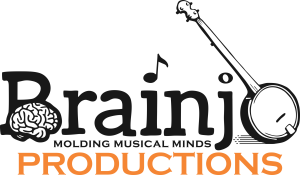The Breakthrough Banjo course for fingerstyle banjo (bluegrass/Scruggs, old time 3 finger, 2 finger, etc.) is now available. The course is based on the Brainjo Method, a musical instruction system specifically designed to maximize the learning potential of the adult brain. To help you learn more about Breakthrough Banjo and the Brainjo Method, the introductory video to the course is posted below.
The video is divided into 4 sections (scroll down for the toggle menu): 1. About the Brainjo Method 2. Goals of the Course 3. The Styles You’ll Learn 4. Course Overview.
Links Mentioned in Video (note: the articles are housed at clawhammerbanjo.net):
Want to learn more? Below are some common questions folks have about the course, along with samples of some of the course materials. If you have a question and don’t see it below, just let me know.
Q: What is fingerstyle banjo?
A: Fingerstyle banjo refers to any style of banjo playing where the fingers pluck up on the strings (rather than in downpicking styles, like clawhammer, where the strings are picked by a downward movement of the fingers).
Within the category of fingerstyle banjo there are many divisions: Scruggs style (a.k.a. “bluegrass”), melodic style, old-time 3 finger, old-time 2 finger (thumb lead, index lead).
In this course, you won’t just be learning one style. You will learn them all.
Q: Isn’t learning all those styles going to be really hard? Shouldn’t I stick to one?
A: NO!
You’ll be learning all these styles because:
- It’s much easier to learn this way (more on why this is in an upcoming “Laws of Brainjo” article).
- You’ll be able to make a lot more great music on your banjo that way.
Q: Who’s this course for?
A: It’s for people who want to learn how to play the world’s greatest instrument, the 5-string banjo! And to learn it in the most effective, efficient, and fun way possible.
It’s also for people who don’t want to waste time figuring out what they should learn or learning the wrong things at the wrong time.
For people who want to learn to play the banjo. And learn to play it really well!
The course is based on the Brainjo method of instruction, which has been specifically designed to maximize the learning capacity of the adult brain, and to provide anyone, regardless of age or prior musical background, a step-by-step path to success.
(RELATED: Click here to learn more about the Brainjo Method.)
The reason most people don’t end up reaching their goals in learning the banjo has nothing to do with their own innate musical ability or talent, and everything to do with not being given the proper learning sequence.
With most music instruction, you’re given what you need to learn, and it’s up to you to figure out how to learn it. In the Breakthrough Banjo course, that’s all taken care of for you. All you have to do is show up, follow the roadmap, and have fun.
In short order you’ll surprise yourself (and your friends and family) with your banjo playing prowess!
The course will be similar in design and instruction to the Breakthrough Banjo course for clawhammer banjo, which is also based on the Brainjo Method of instruction. Here’s what some folks have said about that course:
Q: How does the course work?
A: The course is divided into a few separate sections, each with its own purpose.
SECTION 1: The Primary Teaching Modules. In the first several months, you’ll receive a new teaching module each month. Each module covers a particular skill or set of skills, and are placed in a deliberate sequential order. Each module will consist of:
1) a primary teaching video where the skill is taught.
2) exercises for practice and reinforcement.
3) tasks to complete to know when you’re ready to move to the next module.
SECTION 2: Supplemental Learning Modules. These modules cover areas of banjo playing and music that aid in your overall development player development, but that do not involve “hard skills” (where the learning sequence is critically important). Things such as banjo setup, music theory, creating arrangements, and so on. As such, members can visit these modules at any point in the learning process.
SECTION 3: The Banjo Song Library. Having a body of music to learn that you’re inspired to learn and that is appropriate for your skill level is critical to your continued development as a musician. The song library exists to meet this need by providing a large and expanding library of songs, with arrangements geared towards the various Brainjo levels to ensure you’re able to make great music regardless of where you are on the Timeline of Mastery.
The library will initially be populated by the 50 Top Songs for Fingerstyle Banjo.
Each song in the library will have both a tune tutorial video as well as backup track videos at various tempos.
Below is an example of the tune tutorial videos for the song “Long Journey Home.”
“Long Journey Home” Tune Tutorial – Brainjo level 2
“Long Journey Home” Tune Tutorial – Brainjo level 3
And here is the backup track for “Long Journey Home,” designed to allow you to work on practicing the song you’ve learned, as well as backup, chord changes, fingerings, and positions, jamming, improvisation, and so on. Click here learn more about the backup tracks and ways they can be used.
“Long Journey Home” Backup Track
Visualization tracks: In addition to the mp3 audio files of the backup tracks, you’ll also receive audio files of the lead banjo parts, so that you can listen to these when away from your banjo to reap the ear-building benefits of visualization (click here to learn more about the power of visualization in the learning process).
Jam Dojo – Like it sounds, the purpose of the jam dojo is to practice jamming. It consists of backup tracks for all the songs, grouped by key, to mimic the experience of a jam. Whether you plan to ever play in a jam or with other musicians, practicing in the jam dojo will greatly enhance your musical abilities.
Q: Can I learn both clawhammer and fingerstyle banjo at the same time?
A: Absolutely!
I, and many other people, have been simultaneously learning both styles for many years.
The great thing about these two approaches is that they are similar enough (both involve banjos, the fretting hand work is the same) to be complementary, but different enough (with respect to the picking hand in particular) so that they don’t interfere with each other.
There are so many wonderful ways to make music on the banjo, and there’s no reason not to learn them all.
Q: Should I learn fingerstyle if I already play clawhammer?
A: Yes! Already knowing how to play clawhammer style is to your advantage. And there are even parts of the course targeted towards those who have a clawhammer background.
Learning fingerstyle will also expose you to new material and music you may not otherwise encounter but which, as a fan of the 5 string, you’re liable to enjoy!
Q: Is fingerstyle banjo good if I want to sing and play?
A: One of my favorite things to do is sing and play the banjo.
There are some who may have the misconception that fingerstyle banjo isn’t as well suited to solo vocal backup as clawhammer banjo. This is true of one particular style – 3-finger Scruggs, as it tends to shine best in a band situation, when there are other instruments in the mix.
Other finger styles, however, are very well suited to solo playing, and likewise to vocal backup. And there’s a long tradition of folks playing and singing fingerstyle because of that.
Doing so successfully simply depends on playing in ways that support the voice as solo backup. In the Breakthrough Banjo course, you’ll learn exactly what those ways are!
Q: I tried playing 3-finger banjo before but became frustrated by my slow progress. Should I go back to basics?
A: First of all, you’re not alone. Most folks who set out to learn 3-finger style don’t make it very far.
Not because it’s hard, but because most folks aren’t given the proper path to success.
The sequence and structure of the learning process is important when learning any new skill, but it’s especially important when it comes to fingerstyle banjo.
So if you’ve tried in the past and found yourself frustrated, you’re exactly who I had in mind when I created this course! Everyone who wants to play music well deserves to be able to do so. The number one goal with Brainjo is to ensure nobody gets left behind.
Q: What type of music will I be learning?
A: While there is a large body of traditional material associated with the banjo, I know that there are some folks who like to venture outside the tradition.
The banjo is a more versatile instrument than most folks realize, and one of the objectives of the course is to demonstrate that versatility, and show how you can use it yourself.
While the songs covered in the primary teaching modules – especially early on in the course – will generally lean towards the more traditional stuff, the song library will contain selections outside of that domain.
Furthermore, as your technical skills expands and your ear develops, you’ll ultimately learn how to create your own arrangements of whatever music you’d like.
Q: What’s the ultimate goal of the course?
A: The goal of this course is to provide you with the tools and resources to take you as far as you wish to go in your banjo learning journey.
All the way from never having touched a musical instrument – if that’s the case – to being a fluent banjoist, defined as the ability to take imagined sounds in your mind and bring them out into the world through the banjo.
There are a great many milestones along the way in this journey, and reaching for and achieving those milestones is really where the fun is at. After all, in the end life is a journey, not a destination, so the real goal of this course is to provide you with the musical journey of a lifetime.
Q: I’m ready to get started! How much does it cost?
A: The course itself will be $7 for the first trial month, which gives you access to all the course materials, and then $21 per month thereafter. You can cancel at any time.
Q: How do I cancel?
A: You may cancel your course membership at any time. Once you sign up, you’ll have your own member account page, which has a cancelation link. Alternatively, you can simply contact me via email.
Q: What if I don’t end up liking it?
A: My goal is for you to make consistent progress in learning the banjo, reach your goals, and have loads of fun along the way. If that doesn’t happen, let me know, and I’ll give you a full refund.

 Subscribe to the Fingerstyle Banjo Channel
Subscribe to the Fingerstyle Banjo Channel “I’m so loving your course. Haven’t been this excited about something in a long time. I’m naturally a slow learner, but I have stubbornness, and now your course on my side. “
“I’m so loving your course. Haven’t been this excited about something in a long time. I’m naturally a slow learner, but I have stubbornness, and now your course on my side. “




 “I cannot stress how many times I had tried and failed at Drop Thumbing until I went through the Breakthrough Banjo Course and had it both explained to me and shown to me in depth alongside the exercises. Now it actually feels natural and I can hardly believe it.
“I cannot stress how many times I had tried and failed at Drop Thumbing until I went through the Breakthrough Banjo Course and had it both explained to me and shown to me in depth alongside the exercises. Now it actually feels natural and I can hardly believe it.